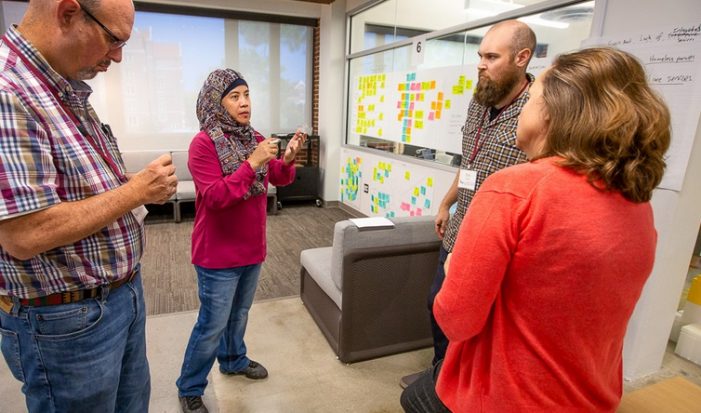By Dave Heller, FSU News
Florida State University embarked on a mission to harness the brain power of some of the community’s brightest people and teach them new skills to tackle the persistent problem of homelessness.
Florida State faculty members led an effort at the FSU Innovation Hub to show local business, government and education professionals how to use an effective and creative problem-solving process called “Design Thinking.”
FSU’s “Design Thinking Deep Dive” included about 25 community leaders who participated in brainstorming sessions over three days in July.
Innovation Hub Director Ken Baldauf, a Design Thinking instructor who’s taught these techniques to hundreds of students and many community groups, described this next-generation approach to problem-solving as a framework for innovation.
“Design Thinking is an organized way to understand a problem and develop broader solutions, and that’s a more effective structure,” he said. “People typically pluck ideas out of the air that they think will work based on their personal experience, but that approach tends to have a very narrow perspective on a problem.”
The “Deep Dive” focused on homelessness in the Big Bend region.
On any given day in Tallahassee, an estimated 1,000 people are homeless. About 15 percent are children. The Kearney Center in Tallahassee, which is the only emergency overnight shelter between Pensacola and Gainesville, typically serves more than 300 people a night.
At Innovation Hub, workshop participants split up into six groups to confront the issue in three stages, starting with the empathy phase, moving to an ideas phase and ending with an experimentation phase to test proposals.
In the empathy phase, problem-solvers created “personas” based on an aggregate of characteristics of those struggling with homelessness. The goal was to develop ideas tailored specifically to help a variety of homeless individuals.
“For example, one persona is an older man struggling with addiction, another is a young mother with children, another is a youth who’s aging out of foster care,” said research faculty member Emily Pritchard, who teaches this process at FSU’s College of Medicine and the Jim Moran School of Entrepreneurship. “Each persona represents a group of people whose homeless experience may be different, and therefore the solutions to help them also would look different.”
In each stage, instructors guided participants through a simple protocol that allowed them to use many techniques to clarify the issue.

“Design Thinking brings together teams of diverse people with diverse perspectives and shows them how to brainstorm in a structured process,” Pritchard said. “This challenge has focused on what ideas are feasible and how to be intentional about solutions.”
The workshop’s space in Innovation Hub started to look like a large art room displaying the creativity of problem-solvers as they wrote down dozens of ideas on bright Post-It Notes — pink, sky blue, lime, tangerine — and pasted them on every available whiteboard and wall.
They generated a lot of ideas, and that was the goal.
“The purpose of the Post-It Notes is to capture ideas individually so you get lots of ideas to evaluate,” Baldauf said. “Then you can arrange them and see which ones have something in common and which ones are new. It’s a mapping technique — a tool that helps new ideas emerge, and that really is the magical part of this process.”
From those mappings, or visualizations, a large team of people with different backgrounds can produce a common understanding about the issue at hand with a roadmap toward solutions.
“This approach enables us to consider solutions that we might not have thought of before,” Pritchard said.
One of the solutions to come out of the workshop was a proposal to create a financial literacy boot camp and microloan program for homeless people to help them avoid expensive payday loans.
Another idea focused on teenagers aging out of Florida’s foster care system. Workshop participants considered better ways to use social media and technology to help former foster children connect with mentors and community services.
Additional proposed solutions included offering job training to help people rejoin the workforce, developing affordable, flexible child care services and creating an app for college students that would help them put together a clearer financial roadmap.
For more information, visit the FSU Innovation Hub.


Most Homeless People are single, I said most, not ALL, so, Barracks like what the Military uses can be constructed where they can live. Set them up just like the Military Barracks, long open rooms with Cots, Foot Lockers and a Stand Up Closet, Showers and Bathrooms. Build several together, for both Men and Women. In the middle build one that is a large Kitchen and Dinning Hall. For their Room & Board, they must work there maintaining the place OR they are taken Down Town and to the Parks to clean them up. The LCS donates a couple of Busses to transport them to their Work Locations. Each one receives an assigned Job Duty to perform, either at the Barracks, at the Parks or Down Town. They are paid a small stipend as well.